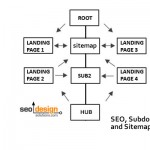One of the most undervalued aspects of SEO is the amount of time it takes to develop a website properly. People often wonder why SEO pricing is so exorbitant, it is because you have to work holistically across various metrics and have a baseline of SEO best practices in order to create the appropriate signals that translate into website and page authority.
Having said that, here is a checklist of the most important things you can do today, that will have the most impact for your web property tomorrow and keep your development process on track for the long-haul without bleeding through resources in the short-term.
In part one, today, we will cover:
- Site Structure
- Content Development
- Sitemaps
- Internal & External Links
In part two, “the next post”, we will cover:
- Social Media Engagement
- Traditional and Deep Link Directories
- RSS Directories
- Conversion Optimization
Site Structure:
In our testing, what we have found is to (1) “theme and silo” content (meaning have the main landing page as the (parent) theme and then (2) add contextual (child pages) using related keyword-rich articles within the “theme” / category to create buoyancy for the preferred landing page and develop authority.
If internal linking is executed within those articles (which they should) then you should either (a) link to the parent theme or (b) link to other themed landing pages that correspond to the keyword that dominate that pages title, url structure and on page content.
Mirroring “exact match” titles with the “exact-match” URLs (using a mod rewrite or ASAPI rewrite if you use windows servers) in tandem with “exact-match” H1 tags consolidates 90% of the on-page factors required to make a dent in the SERPs (search engine result pages).
Aside from the basics listed above, you should try to avoid ?’s in url parameters such as a product named ?Pd0923-product.php vs. just product.php which is an SEO friendly pretty URL, to avoid creating an undesirable meal for search engine spiders (who must first crawl and index your content before it can pass on link-flow, authority or rank).
Content Development:
Unless your website to die a slow and uneventful death, then adding fresh unique content is a must. Yes, there are alternatives such as using content created from others and then attempting to monetize that traffic with contextual links as a viable traffic source; but for SEO, unique content that is (a) informative (b) thought-provoking and (c) original works best.
Depending on your budget, amount of time you can dedicate to your property a post a day is ideal, and once those posts start getting indexed quickly then if you can up to post frequency to three a day (400 words or more) that is the way to fast-track your domain into an authoritative position.
Sitemaps:
Using sitemaps for search engines is SEO 101, yet under the right circumstances can be utilized in an advanced SEO setting. The use and implementation of sitemaps is dependent on the size of your website, but has added bonuses for each type of sitemap.
Static Html Sitemaps (with less than 100 outbound links) is best, but aside from that, you can use dynamically generated XML sitemaps as (a) a way for search engine spiders to reach those pages or (b) as a secondary source of internal navigation to feed child / internal pages by deep linking (simply linking to them from sites other than the site they are on) to distribute the link-flow to all the pages evenly.
This is critical as a site grows to offset link-attrition and avoid pages going supplemental from lack of peer review from outside sources.
Internal & External Links:
Links are the only way you can move from site to site and from page to page within a site, therefore, treat each one with the regard it deserves. Of all of the principles of linking, the most critical it to mitigate loss by consolidating the number of outbound links on a page and ensuring that a page has at least 5 internal or external links pointing at it from (a) within your own website or (b) from other sites.
Internal links aid the ranking process from using the referential integrity of the collective attributes of your pages (since search engines see all of your content as a vector and not as separate pages but rather as one massive document with specific weights for specific terms).
The way you link within documents to each other will create an exit point for search engines when they use inverse document frequency to identify the segment with the highest concentration of correlations to the search query submitted.
So, if your page that has the most relevance is orphaned (lacks inbound or deep links) then its importance to (a) your own website or (b) to the web at large is greatly eclipsed by its lack of prominence.
To correct this you can (1) choose one anchor and link consistently from every occurrence (once per page) on other pages where those keywords occur or (2) link from various related keywords to a page to provide that page with the ability to rank as a hybrid across multiple mid-tail and long-tail variations (keyword variations based on the main parent/ keyword theme.
Things such as singular and plural variations or polynyms also fall under this category such as pricing, rates, fees, costs, etc. which all mean the same thing yet stem from other semantic roots.
Based on the quantity and quality of the inbound links from other sites, the link flow coming from them (based on how many outbound links are on the page), how strong the domain is, how strong the link weight within the domain is to the page the link is from, how themed and relevant the page that is linking is to the target and how much trust the page or domain has determines the degree of the push you receive from the link.
Get enough inbound external links (deep links) and they are like fuel for your SEO efforts, but inbound links from other sites through link building is not enough unless you have the corresponding on page SEO and internal links to capitalize on that link-flow once it gets there.
That is why you want to (1) leverage content development (targeting multiple keywords based on the market/phrases that have high conversion) and (2) create corresponding landing pages for each keyword that has more than 100K competing pages (use “quotes around the keyword in Google”) to determine the barrier to entry for that phrase.
The more landing pages you have with supporting silo/child pages, internal links and deep links from other sites – the better your odds of crossing the tipping point and capturing the top 10 position for a trophy keyword that is backed by conversions, replete with commercial intent.










I guess this post will really help a lot other people who is starting in this industry just like me. Keep good tips coming.. Thanks for this wonderful post.
Mondex:
You are correct in your assumption, if we go too deep, then we only attract other SEO types, which can be a good thing for a forum.
Yet on the other hand, it breeds more competition, hence, our readers are more of the do it yourself types looking for tips and tactics.
Glad you enjoyed the post and look forward to part 2 tomorrow.
Thanks for the tips. I appreciate stuff like this that touch up on the basics. Many people are making SEO a complicated thing that newbies are starting to be confused with what they need to do.
Indeed, everyone has to start somewhere and you know as well as I do, its not always the stellar aspects of advanced SEO that are the problem, its the repetitive simple stuff that can make the difference.
Thanks for visiting…